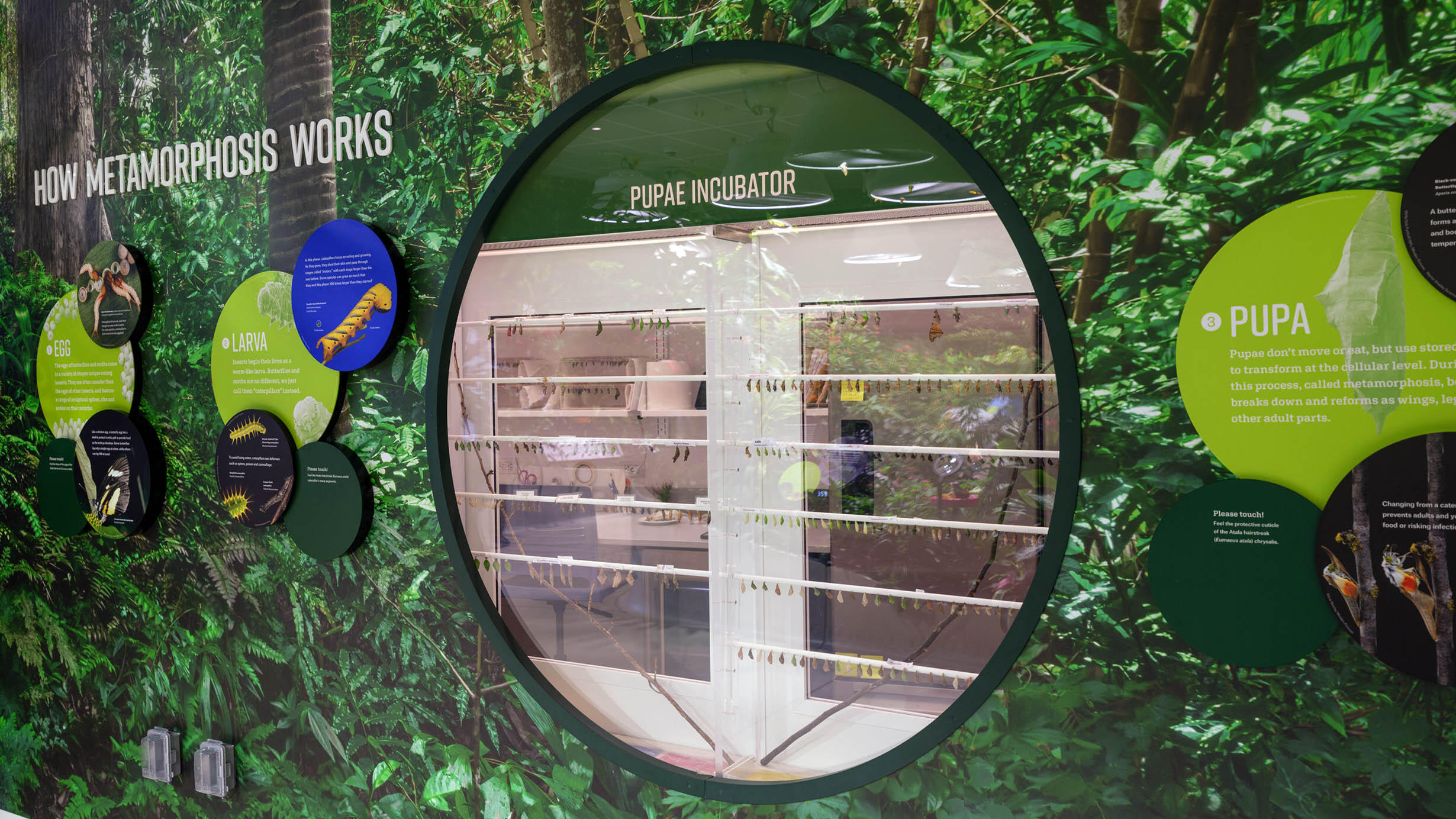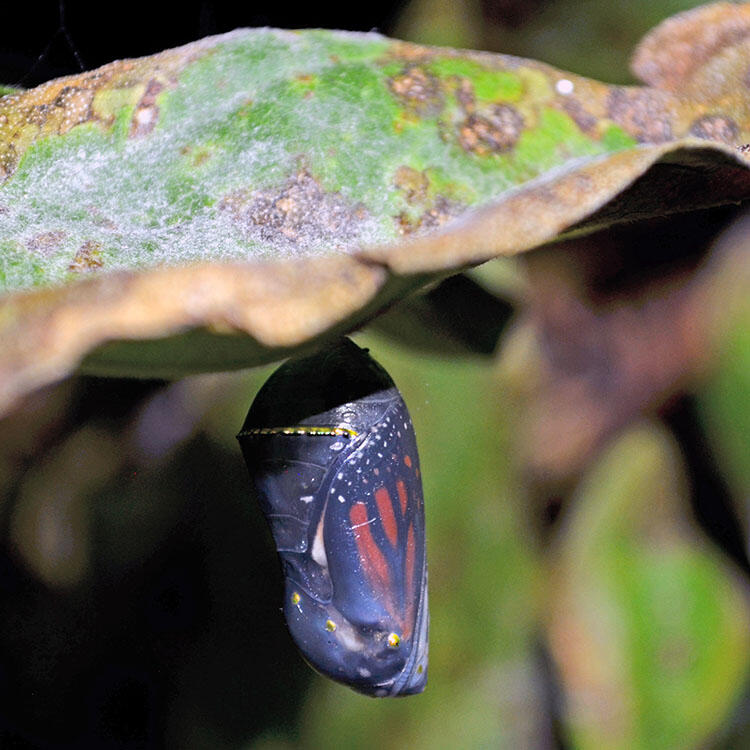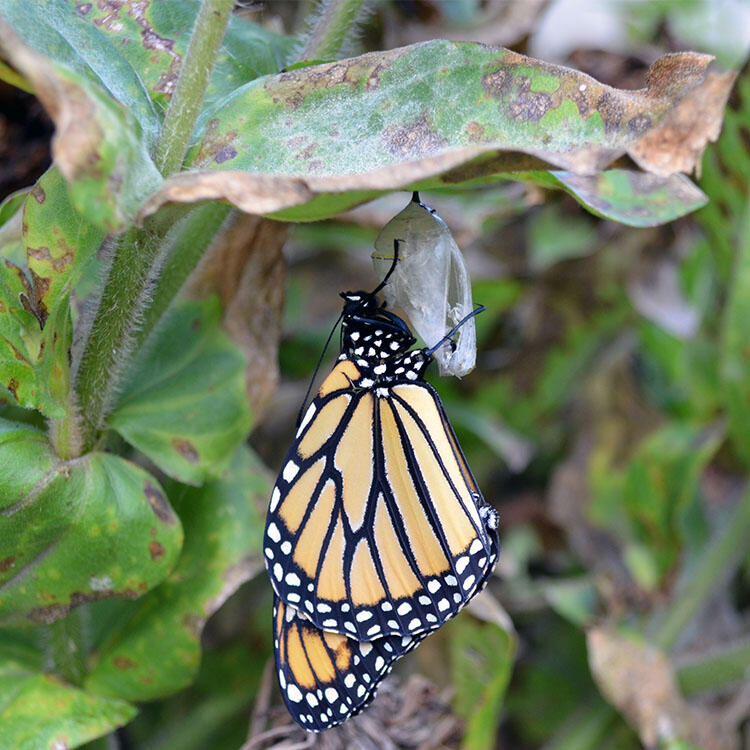Butterfly Metamorphosis
Part of the Davis Family Butterfly Vivarium exhibition.
 Alvaro Keding/© AMNH
Alvaro Keding/© AMNH The butterfly begins life as an egg, emerges as a caterpillar, and then undergoes a complete change in body form during development.
[MUSIC]
[The American Museum of Natural History logo appears, with animated butterflies flying all around it.]
NARRATOR: How do you make a butterfly?
[Text appears: How do you make a butterfly? A pattern of leaves slides onto the screen.]
[RUSTLING]
NARRATOR: First, a butterfly lays an egg on a plant.
[A butterfly lands on the leaves and then flies away, leaving an egg behind. Text appears at the top of the screen: “1. Lay an egg.”]
NARRATOR: A caterpillar hatches out of it, and gets busy eating.
[Text at the top of the screen changes to “2. Hatch.” A tiny caterpillar munches its way out of the egg [CRUNCHING SOUND] and starts crawling along the leaves. Behind it, holes appear in the leaves. Text at the top of the screen changes to “3. Eat, molt, repeat.”]
NARRATOR: As it eats, it grows and molts out of its skin to get even bigger,
[The caterpillar grows and then its skin slides off it, revealing a more brightly colored caterpillar beneath it. More holes appear in the leaves behind it.]
NARRATOR: And repeats this until it is a fully-grown caterpillar.
[The caterpillar sheds its skin a second time, and it is now much much larger than when it hatched out of the egg.]
NARRATOR: It attaches itself to a plant-
[The caterpillar crawls along a branch and then flips to hang from the underside of the branch from its back end.]
NARRATOR: and sheds its skin one last time to reveal its chrysalis.
[The caterpillar sheds its skin again and reveals an oblong green chrysalis beneath. Text at the top of the screen changes to “4. Pupate”.]
NARRATOR: Inside, the tissues that made up the caterpillar rearrange,
[Three circular graphics spiral out from behind the chrysalis. One contains a close-up of a caterpillar face, one contains a close-up of a caterpillar leg, and one contains a close-up of the caterpillar body. Text at the top of the screen changes to “5. Form a butterfly”.]
NARRATOR: to form a head and body, six legs, and four wings.
[The images inside the circles morph into a butterfly head, legs, and wings. The image spiral back behind the chrysalis.]
NARRATOR: Then, when its own genes and the climate indicate the time is right,
[A moon rises and falls, as if night and day are passing quickly. The chrysalis gets darker in color and starts to wiggle.]
[POP]
NARRATOR: out pops the butterfly.
[Text at the top of the screen changes to “6. Emerge!” A butterfly with orange and black wings pops out of the bottom of the chrysalis, now nearly transparent, and rests on the outside of the chrysalis. Its wings go from crumpled to flat.]
[A butterfly egg appears on screen. It shifts counter clockwise and is replaced by a caterpillar.]
NARRATOR: This entire cycle, from egg to caterpillar, to chrysalis to butterfly,
[The caterpillar shifts as the screen zooms out to reveal a circle, with the four stages (egg, caterpillar, chrysalis, and butterfly) circling counter clockwise.]
NARRATOR: Is known as metamorphosis, because the animal goes through striking, distinct, life stages.
[TYPING]
[Text appears over the rotating cycle: “Metamorphosis. Noun: the process of transformation in distinct stages.” The text fades and the butterfly on screen flies offscreen.]
NARRATOR: Now our butterfly will find a mate
[It flies into the sky where there is another butterfly flying.]
NARRATOR: so it can start the butterfly life cycle all over again.
[The butterfly flies onto a plant, and flies offscreen, leaving a butterfly egg behind. The plant lowers off screen and butterflies fly all around.]
NARRATOR: See live butterflies, moths, and chrysalises
[Text appears: “See live butterflies, moths, and chrysalises”. It disappears offscreen.]
NARRATOR: in the American Museum of Natural History’s Butterfly Conservatory, now in its 20th year.
[The American Museum of Natural History logo appears, and beneath it text appears: “Butterfly Conservatory. www.amnh.org/butterflies”]
[Credits roll.
Generous support for The Butterfly Conservatory has been provided by the Eileen P. Bernard Exhibition Fund.
Video
AMNH / L. Stevens
Illustration
AMNH / M. Fearon
Sound Effects
AMNH / L. Stevens
InspectorJ
Music
“Bug Talk” by Will Collier (BMI) / Warner/Chappell Production Music
© American Museum of Natural History]
Egg
The eggs of butterflies and moths come in a variety of shapes unique among insects. They are often rounder than the eggs of other insects, and feature a range of sculptural spines, ribs, and scales on their exterior.
Like a chicken egg, a butterfly egg has a shell to protect it and a yolk to provide food as the embryo develops. Some butterflies lay only a single egg at a time, while others can lay 100 at once.
Larva
Insects begin their life as a worm-like larva. Butterflies and moths are no different–we just call them "caterpillars" instead.
In this phase, caterpillars focus on eating and growing. As they grow, they shed their skin and pass through increasingly large stages called "instars." Some species can grow so much that they end this phase 100 times larger than they started!
Courtney Celley/USFWS/Wikimedia Commons
Caterpillars live to eat and start doing it as soon as they hatch. For some species, a caterpillar's first meal is its own eggshell.
To avoid being eaten themselves, caterpillars use defenses such as spines, poison, and camouflage. For example, many caterpillars eat plants that contain toxic chemicals. As they eat, the caterpillars store the toxins in their bodies. When they become butterflies, they remain poisonous, and predators learn to stay away.
Pupa
A butterfly pupa, also called a chrysalis, forms a cuticle that encloses its head and body to shield against extreme temperatures, parasites, and drying out.
Edward K. Boggess/USFWS/WikiMedia Commons
Many moth species wrap themselves in a silk covering, called a cocoon, for the same kind of protection.
Pupa don't move or eat. They use stored energy to transform at the cellular level.
During this process, called metamorphosis, body tissue breaks down and reforms as wings, legs, and other adult parts.
 A late-stage chrysalis of a monarch butterfly
A late-stage chrysalis of a monarch butterfly Tina Shaw/USFWS/Flickr
 A monarch butterfly emerging from its chrysalis
A monarch butterfly emerging from its chrysalisTina Shaw/USFWS/Flickr
Changing from a caterpillar to a butterfly or moth prevents adults and young from competing for the same food or risking infection from the same diseases.
Adult
When it's fully grown, the primary goal of a butterfly or moth is to disperse and reproduce.
Mating pairs find each other in the same habitat where their host plants grow. They use scents and elaborate aerial dances for courtship displays.
For some butterflies, their lifecycle takes place across entire continents. Every few generations, monarch butterflies fly over 2,000 miles (approximately 4,500 km) away from where they hatched to lay their eggs.